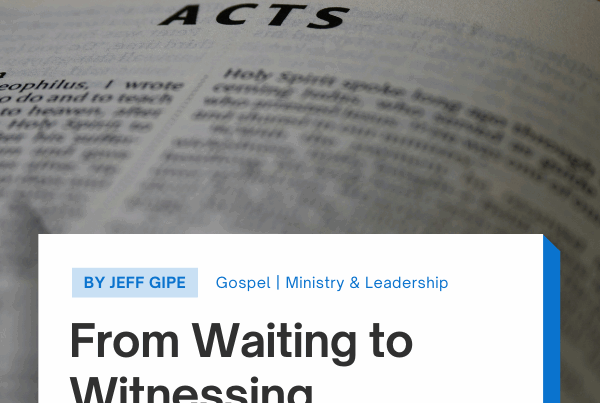
While there are many preachers more exciting to listen to than myself, students at Calvary Chapel Bible College often ask me how I do sermon preparation. To better serve those that ask me this question, I decided to write down my full 15-step process. It’s important to note that before I start, I pause to make sure I enjoyed my morning devotions. It’s a fail to only spend time with the Lord while prepping a sermon. The following is my step-by-step method for creating a sermon when given ample time to prepare:
1. Spend time READING the passage and PRAYING for understanding.
Printing out the sermon text from BibleGateway allows the passage to be marked up freely. Be sure to understand the context to prevent abusing the passage. It is also valuable to begin thinking about different groups of people who will be listening. For example, what will a non-Christian think when they hear this text? What will an uninformed new Christian think? What will a mature Christian think? What will a Christian wandering away think? How do I engage each of these groups to get them on board?
2. OUTLINE each phrase or verse.
Meditate on the passage, ask questions, write lists, jot down correlating Scripture from memory, etc. At this stage, I avoid looking at commentaries (so I can think for myself), but I may look at other English translations and basic Greek word definitions. These are the important questions to consider while outlining: What will confuse the people when they hear this text that should be clarified? What do they need to know to understand it? What does this text mean, but also what is God looking to achieve by it in our lives? What result is God looking for when he says these words?
3. TRANSCRIBE my handwritten notes digitally.
Sermon preparation can be digitally finished from now on. My sermon notes are arranged in my personal standard sermon format that I always use (margins = 0.25, font size = 21). The font is large because I teach from an iPad. At this font size it’s best to aim for 5-8 pages of notes for a 40-45 minute sermon. I start most messages with three basic sections: introduction, message and conclusion, and modify as the sermon develops.
4. Research CROSS-REFERENCES.
Search for helpful correlating scriptures before looking to commentaries. I use Bible Hub or Logos Bible Software to find good sources. The Treasury of Scripture Knowledge is also available as a detailed cross reference library.
5. Research COMMENTARIES to make sure the passage is understood correctly.
This is the time to input amazing quotes, correct theological errors (thank you Lord!) and make sure all quotes are cited. It’s a good idea to make notes about how the commentary quote will be used to help jog the memory later on. Commentaries can be found through Bible Hub, Blue Letter Bible and Logos.
6. Finalize the MAIN IDEA & write the CONCLUSION.
At this point with research, the main point of the passage and its application should be decided. I put this main idea in the form of a thesis statement in the introduction. This statement should clarify the reason why people should keep listening. Writing the conclusion (at least in raw form) is helpful for keeping each sermon point on track.
7. Prayerfully ask God to help me REPENT and OBEY the main idea.
One week before the sermon, I ask God to examine my heart for how I have failed in this area of obedience. I repent and preach the gospel to myself about how Christ lived this characteristic perfectly. I then beg the Lord to give me a chance to obey this passage before I preach it. This prayer is a daily part of my devotions in the last week before the sermon, so I can be looking for opportunities to obey.
8. REWRITE SECTION TITLES to correlate cohesively with the main theme.
It helps the sermon flow to title each section with a supporting argument for the main theme. Consider the ways each title can be written for today’s audience in the present tense (NOT “Jonah ran from God…” BUT “We all run from God…”). This is also a good time to edit the sections for consistency and clarity. (I usually repeat this step a few times until the sermon flows better.)
9. Add ILLUSTRATIONS to explain better.
Personal life stories are the easiest to apply (if I am not the hero), but quotes from books and recent news articles (Yahoo Odd News is a funny source) are also helpful for bringing a topic to life. It’s good to have a variety of illustrations: quotes, personal stories, biblical examples, testimonies, news articles, etc.
10. Write the INTRODUCTION last.
The introduction needs to be brief and catchy. It should introduce the main theme of the sermon and share a reason why the congregation should listen. The message theme can be introduced by reading the passage, sharing an illustration, story, quote, article, etc. I usually also give my sermon title, Scripture Passage and It’s Context.
11. EVALUATE the sermon honestly and make changes.
Warren Wiersbe’s questions from The Elements of Preaching are useful for this process:
Is the message based on a correct interpretation of Scripture? Is this what the author was consciously intending to communicate to his audience? Does it exalt the Person and work of Jesus Christ? Will it meet the needs of people and the church’s goals? Is the theme a timeless spiritual truth worth talking about? Is the message organized so that I can preach it clearly and the people understand it easily? Is there a concise and clear statement of purpose? Is there a clear plan of development? Is there practical application? Are all Scripture references and historical facts accurate? Is the message real to me personally so that I may make it real to others? Have I edited out everything that isn’t necessary to the sermon’s goals? Am I preaching to people’s hearts, pleading for obedience to God’s Word? Is the message worth preaching again?
12. Export a PDF and HIGHLIGHT the sermon for iPad use.
I export to a PDF and import it in an iPad app called “Documents” that allows me to highlight the text in different colors systematically and add last minute notes. In case the iPad runs out of batteries (never happened), printing a paper as a backup is imperative.
13. Create the SLIDES for the presentation.
If slides will be used, go minimalist by using large fonts and short sentences. I just highlight scriptures, quotes and main points. Keep it simple by using the same slide design for each series or book of the Bible. If you plan to teach the sermon again, text slides with nice designs age less quickly than images.
14. PRACTICE the sermon by preaching out loud and listening to recordings.
Preaching the sermon to a friend who cares (or a wall alone) helps develop the transitions between points and gives confidence for looking away from the notes. My personal rule is to never stop to write down changes as I am practice-preaching. I pretend people are watching, so if I pause too long, I force myself to move on rather than finding the perfect transition. I try and do this two to three times, once daily, leading up to my sermon. Record the computer reading the sermon notes robotically. Doing this at a fast speed so that the whole 45-minute sermon plays between five and six minutes allows me to listen to the whole sermon multiple times a day (I listen to it 10+ times before actually preaching it). This commits the sermon content to memory, so it’s easily retrieved while preaching. Practically, I do this by having my iPad speak the notes at a fast speed while I record it on my phone.
15. PRAY for the right heart and the people who will hear it.
Pray and repent as necessary (and ask forgiveness of others). It is essential to pray that the motives for teaching are based on giving God glory and love for others, NOT for public praise of clever sermons. The Holy Spirit desires to lead us as we teach and has the authority to steer us in a new direction.
Sometimes I’ll have someone assess my sermon as I preach using THIS CHECKLIST.
To help illustrate these 15 steps, I’ve tracked my progress through a sermon from start to finish. You can VIEW THAT DOCUMENT HERE if you think it will be helpful.









